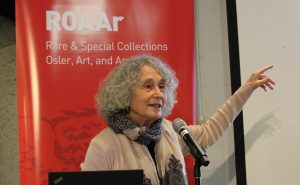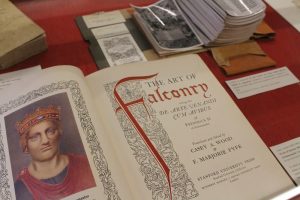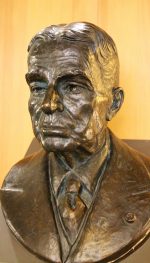Birds, eyes, and bile came into focus at this semester’s ROAAr symposium “The Eyes have it; a Re-appreciation of Casey Wood.” You might wonder what such things have in common; the answer is Casey Wood. Wood was a passionate and driven collector for the McGill Libraries, a generous donor, a scholar, an ophthalmologist, a translator, and a falconry enthusiast. He became known here as the “Birdman of McGill,” and you can browse through some of his legacy in this digital exhibition.
Casey Wood helped shape both the Blacker-Wood Collection of biology and natural history and the Osler Library of the History of Medicine into what they are today; research collections of unique depth and beauty. He also advanced his own field by literally writing the book on the ophthalmology of birds, the Fundus Oculi of Birds. Evolutionary biologist Bob Montgomerie brought a fresh perspective to the Fundus Oculi (See Bob’s blog on Wood’s Fundus Oculi). Wood was fascinated by bird vision, as are all who listened to Bob, an active scientist, explain the relevance and importance of Wood’s book to his research today.

Victoria Dickenson, Adjunct Professor and organiser of the symposium, speaking on the Taylor White paper museum.
One jewel of the Blacker-Wood collection is the Feather Book of Dionision Minaggio. This unique book illustrates birds and pastoral scenes from the Lombardy region using feathers, and only feathers! This book employs techniques copied from central and south American crafts. Carla Benzan presented her work on this book, which has been digitized and made freely available through our Digital collection. McGill once again owes thanks to Casey Wood for this volume, which Wood acquired with the Taylor White paper museum. Taylor White curated his so-called paper museum of birds and animals in the 18th century; all who ‘visited’ the 938 watercolous could be instantly transported to remote corners of the natural world through intricate illustrations and paintings of wildlife. He had a network of painters and illustrators who drew for him. Marmosets, parrots, tropical beauties, ptarmigans and emperor penguins all provided stunning glimpses of far off places to contemporary viewers. Today, they serve as stunning entry points into the field of natural history in the 18th century and the scientific and artistic network that made the paper museum possible.

Mauricio Ruiz, UQAM, gave a lecture in french on Casey Wood and F.Marjorie Fyfe;s Translation of De Arte Venandi cum Avibus
Anna Winterbottom and Soma Hewa also spoke on this aspect of Wood’s work in Sri Lanka. The medical side of Casey Wood’s collecting in Sri Lanka and Southeast Asia resulted in a substantial collection of olas (palm leaf manuscripts) containing the central works of the Ayurvedic medical system. The Osler library collection now contains number of these texts, inscribed onto palm fronds, along with medical objects like earspoons, medicinal eye pencils, and, to quote Anna Winterbottom, a clever medieval medicine box complete with “early modern child lock,” now make up the incredibly rich and diverse collections that McGill has today.
With presentations from scholars in diverse fields of study, Casey Wood and his legacy at McGill came to life through this symposium. More videos of the symposium presentations will be available on the McGill Library Youtube page.
For more details on the symposium, full roster of presenters, and more links see the event page.













Leave a Reply
You must be logged in to post a comment.